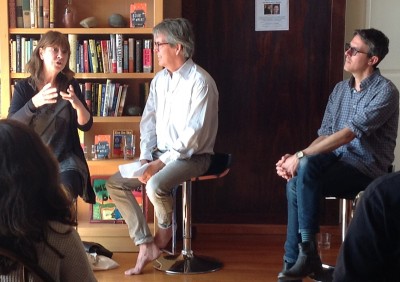
Hemingway recommended to write the draft, just plow through and get it down. Rewrite after that. I think that’s so true because if you get something down it’s easier to see the big picture, figure out what you were trying to say or highlight, and it’s always easier to rework a lump of kneaded clay than not.
– Cara Black
If you want to be inspired by the sheer heady rush of turning ideas into published words, talk to a first novelist. If you want to sharpen the all-important nuts-and-bolts skills of turning good writing into great writing, talk to a veteran with more than a dozen successful titles under her belt – someone like Cara Black, author of the popular Aimée Leduc mystery series set in Paris.
We had Black here at the Wellstone Center in the Redwoods last Saturday for one of our Author Talk events, joined by Nick Taylor, who writes the T.T. Monday baseball mysteries (highly recommended), and it was especially interesting hearing her talk about how once she has a draft, she defines three separate sets of priorities for reading through the entire text again, taking a fresh pass with a narrow focus. “Those three runs are quite different and to me, it’s like a rewrite even though a lot might not be changed,” she says.
ADDING VISCERAL DETAIL: She goes line by line through the book, looking for ways to add sharp description to tickle the senses.
“I have a sensory detail pass where I’m only looking at the senses, i.e., is their a sensory detail on every page (I try) or two? At the beginning of a scene are we oriented, see the light in that place, get reminded of the weather, season? How does the place smell?”
FINE-TUNING LANGUAGE, AVOIDING REPETITION: Many of us tend to do this in fits and stars as we cruise through our manuscript on a general read with many priorities in mind; Black’s approach enables her to tune out those other considerations and sharpen her focus.
“Then I go through and word search for words I know I’ve overused and try to come up with others,” she says. “Often the phrase or words jumps out as clunky and while going through the pages a better way to craft hits me. It’s still a lump of clay until all the pieces and parts smooth out. One time just taking out a sentence at the end of a chapter changed the whole last third of the book.”
MAPPING OUT THE GEOGRAPHY: This is especially important for Black, whose books are each set in a different arrondissement in Paris (starting with her first, Murder in the Marais), leading to a detailed focus on what street connects to which square, and so forth, as intense as James Joyce’s evocation of the particulars of Dublin in Ulysses.
“Then I literally map it out,” she says. “If Aimée is here at this time and parked her scooter there, then make sure she rides the scooter back or leaves it and takes the metro. So: logistical checks. I also timeline to see if that makes sense for the character to be here when they have to get to somewhere else and practical things: Who is taking care of the dog, etc., which people get upset about if I don’t write that Miles Davis went for a walk (dog abuse!).”
Give it a try: The technique might not turn you into a bestselling author with legions of fans, like Cara Black, but it’s sure to make you feel a little more sane – and the finished manuscript is sure to be at least a notch or two better.
– Steve Kettmann
Want to receive Steve’s blog on writers and writing every week by email? Sign up below.

